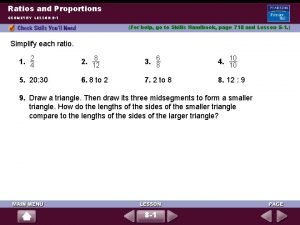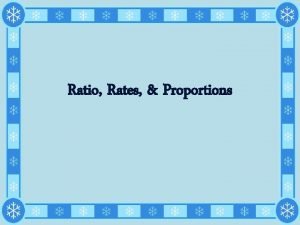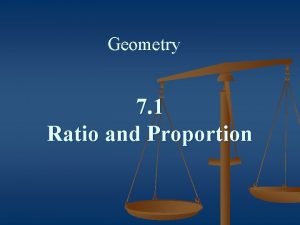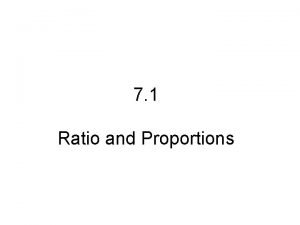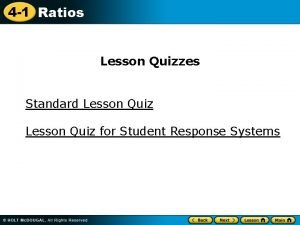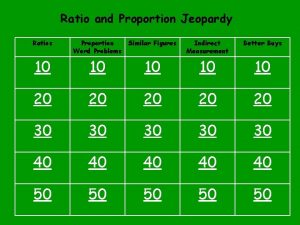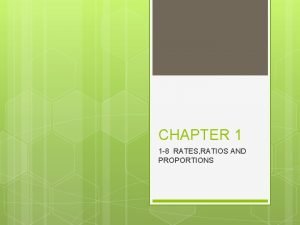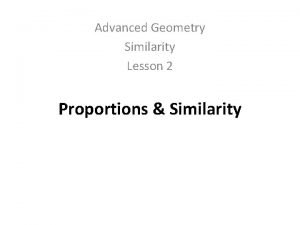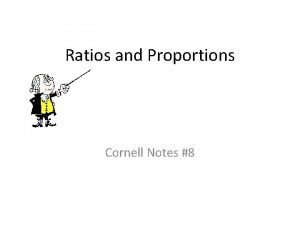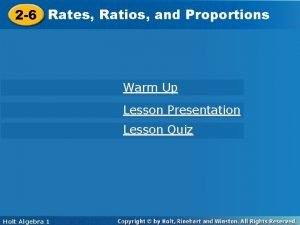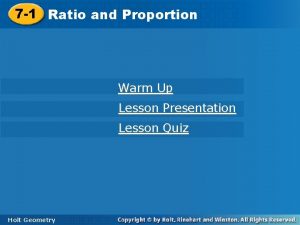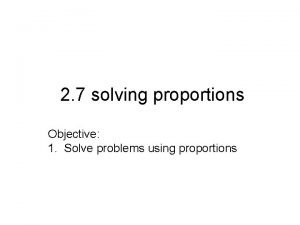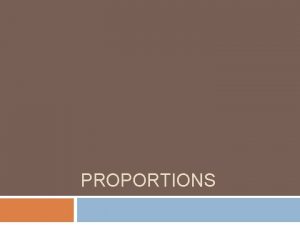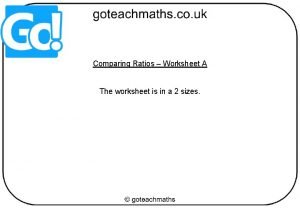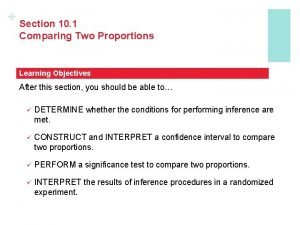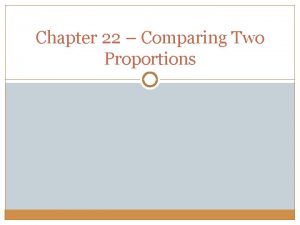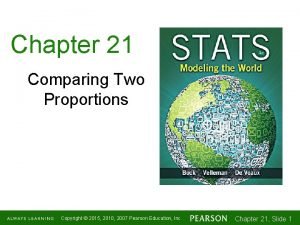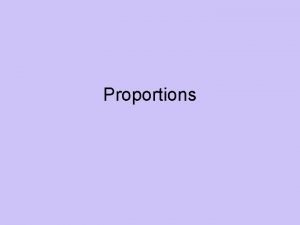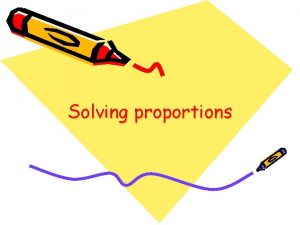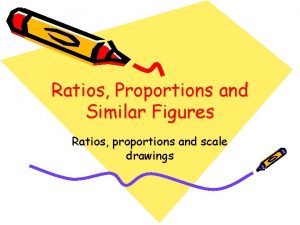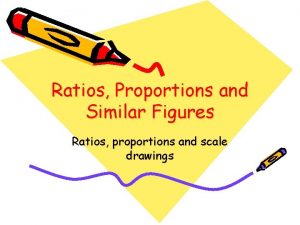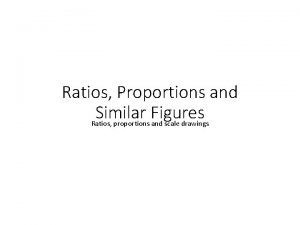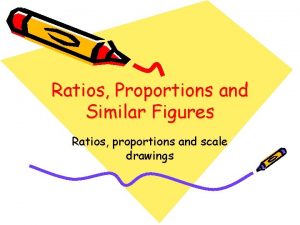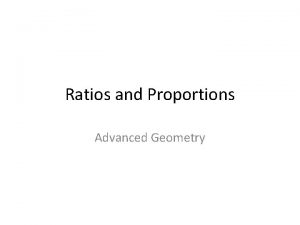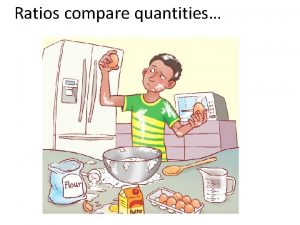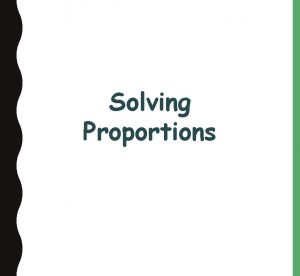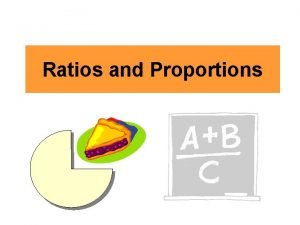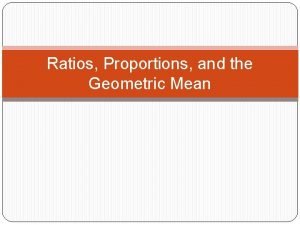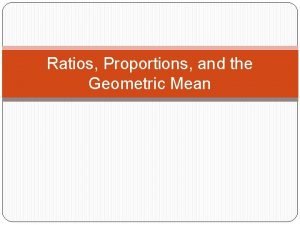SETTING UP SOLVING RATIOS PROPORTIONS Ratios compare two
























- Slides: 24

SETTING UP & SOLVING RATIOS & PROPORTIONS

Ratios compare two quantities (amounts) � We see ratios all around us, and use them casually in conversation on a regular basis! A more common ratio is the speed limit. The speed limit compares two amounts… Miles and Hours This speed limit requires you to drive no faster than 25 miles in 1 hour.

Ratios continued…

For example A classroom has 30 students. 18 are girls. 12 are boys. (Let’s compare the boys the girls. Remember: making a comparison of two amounts is using a ratio. ) The easiest ratio would be 18 to 12. There are 18 girls for every 12 boys. GGGGGGGGG to BBBBBB (18 girls to 12 boys) Or I can divide them into groups of two and say the same thing differently… GGGGGGGGG to BBBBBB (for every 9 girls there are 6 boys) Or I can divide them into groups of six and say the same thing differently… GGGGGGGGG to BBBBBB (for every 3 girls there are 2 boys)

Ratios continued In the previous example, part to part ratios were expressed. The two parts that made up the whole classroom were girls and boys. Girls : Boys However, the numbers can be expressed as part to whole ratios, as well. Girls : Class 18: 30 Boys : Class 12: 30

Proportions Proportions are two equal ratios. We use proportions to help us make constant comparisons of information. We use proportions all the time when shopping! For example: 3 t-shirts cost $15, so 6 t-shirts cost $30. We are able to figure out how much more or less t-shirts will cost by using proportions. Whatever we do to one, we have to do to the other!

Proportions continued… Proportions solve real world problems and word problems. To use them effectively, we have to first identify the ratio that is in the problem, then set up the proportion to help us solve it. Remember: Whatever we do to one, we have to do to the other! (It will be exciting to see just how much we can use this idea!!)

Check out the set up! Identification Part Information Constant of Proportionality Part being compared X or ÷ Total Difference Actual Number Total of the parts X or ÷ Total of the actual numbers Difference of the parts X or ÷ Difference of the actual numbers

Before we practice… 1) 2) 3) Let’s discuss how we should set up the word problem, so we are always successful! Find the two things being compared and write a word ratio! Identify the key words in the problem and assign numbers only to where they belong! Find the relationship* between the numbers and use it to solve for what you want! *The relationship between proportions is also known as the constant of proportionality.

Let’s practice… We’ll start off easy Save At Gabe’s sold some sweaters and books in the ratio 2: 3. The store sold 8 sweaters yesterday. How many books were sold? (www. thinkingblocks. com)12 books were sold! 1) Identify what is being compared. In this problem, it’s sweaters & books! 2) Assign the ratio in the order it is given. Sweaters is first, and 2 is first, so 2 goes with sweaters. Identificatio n Part Info Sweaters 3 2 COP x 4 Actual # 8 12 Books Total 3)Difference Now plug in the remaining number given in the problem. It says 8 sweaters, so 8 goes in the row next to 4) What is your Constant of Proportionality? Which operation did you use to get the 2 to become an 8? 5) Use the same COP to find the other number.

Let’s practice another… Lauren made some trail mix by combining raisins and cereal in a 3: 4 ratio. Lauren used 9 ounces of raisins. How many ounces of cereal 12 ounces of cereal were did she use? (www. thinkingblocks. com) 1) Identify what is being compared. In this problem, it’s raisins & cereal! 2) Assign the ratio in the order it is given. Raisins is first, and 3 is first, so 3 goes with raisins. Identificatio used! Part Info n 3 Raisins 4 COP x 3 Actual # 9 12 Cereal Total 3)Difference Now plug in the remaining number given in the problem. It says 9 oz of raisins, so 9 goes in the row 4) What is your Constant of Proportionality? Which operation did you use to get the 3 to become a 9? 5) Use the same COP to find the other number.

Let’s take it up a notch… Action Sports donated gym bags and bats to the community center in the ratio 2: 3. The store donated 12 bats. How many more bats were donated than gym bags? (www. thinkingblocks. com)

Before we solve… Let’s notice what is different with this problem. Action Sports donated gym bags and bats to the community center in the ratio 2: 3. The store donated 12 bats. How many more bats were donated than gym bags? This question does not want to know how many bats were donated. It wants to know how many more! *If we do not pay attention to what the question wants, we will get the answer wrong.

Let’s take it up a notch continued… Action Sports donated gym bags and bats to the community center in the ratio 2: 3. The store donated 12 bats. How many more bats were donated than gym bags? 1) Identify what(www. thinkingblocks. com) is There were 4 more bats donated than gym being compared. bags! Identificatio Part Info COP Actual # 2) Assign the ratio in the order it is 3)given. Plug in the n 2 Bags 3 x 4 12 remaining number given in the problem. Total 3– 2=1 x 4 4 *Because the problem does not want to just know how many bats, we need to use more rows in our table. Bats Difference *How many more means subtract, so we also will use the Difference row. 4) Subtract the parts. 5) Figure out the Constant of 6) Use the same COP to find the other number you need.

Let’s do another like it For every 3 knee-bends Henry can do, Emily can do 2. If Henry did 24 knee-bends, how many more knee-bends did Henry do than Emily? (www. thinkingblocks. com) Henry did 8 more knee-bends than 1) Identify what is being compared. Emily! Identificatio Part Info COP Actual # 2) Assign the ratio in the order it is given. 3) Plug in the remaining number given in the problem *Because does not want to just know how many bats, we need to use more rows in our table. n 3 Henry 2 x 8 24 x 8 8 Emily Total 3– 2=1 Difference *How many more means subtract, so we also will use the Difference row. 4) Subtract the parts. 5) Figure out the Constant of 6) Use the same COP to find the other number you need.

Crank it up some more, please! Monica and Nicole together have 45 coins. They decided to share the coins in the ratio 3: 2. How many coins did Monica get? (www. thinkingblocks. com)

Before we solve… Let’s notice what is different with this problem. Monica and Nicole together have 45 coins. They decided to share the coins in the ratio 3: 2. How many coins did Monica get? (www. thinkingblocks. com) This question is tricky! The ratio it gives is a part: part, but the actual number (45) it gives is the total! We have to be careful where we place the number! *If we do not pay attention to what the question is saying, we will get the answer wrong.

Crank it up some more, please cont… Monica and Nicole together have 45 coins. They decided to share the coins in the ratio 3: 2. How many coins did Monica get? (www. thinkingblocks. com) Monica got 27 Identificatio coins! Part Info COP 1) Identify what is being compared. n x 9 3 2) Assign the ratio Monica 2 in the order it is Nicole given. x 9 3+2=5 3) Plug in the Total remaining number given in the Difference *Together means add, so we also problem. *Notice 45 is shared, so will use the Total row. it is a total. We need to 4) Add the parts. use more rows in our table. 5) Figure out the Constant of Actual # 27 45 6) Use the same COP to find the other number you need.

Let’s do another like it During the holiday sale, Penny Pinchers sold books and CDs in the ratio 4: 7. The store sold a total of 88 items. How many CDs were sold? The store sold 56 Identificatio CDs! Part Info COP (www. thinkingblocks. com) 1) Identify what is being compared. n 4 2) Assign the ratio Books 7 x 8 in the order it is CDs given. x 8 4 + 7 = 11 3) Plug in the Total remaining number given in the Difference *Total means add, so we also will problem. *Notice 88 is a total. We use the Total row. need to use more rows 4) Add the parts. in our table. 5) Figure out the Constant of Actual # 56 88 6) Use the same COP to find the other number you need.

Try to blow my mind! … I’ll blow yours instead! Miguel spends 4 out of every 7 dollars he earns on puzzles. He uses the rest of the money to buy snacks. Last month, Miguel spent 12 dollars on puzzles. How many fewer dollars did he spend on snacks? (www. thinkingblocks. com)

Before we solve… Let’s notice what is different with this problem. Miguel spends 4 out of every 7 dollars he earns on puzzles. He uses the rest of the money to buy snacks. Last month, Miguel spent 12 dollars on puzzles. How many fewer dollars did he spend on snacks? (www. thinkingblocks. com) This question is REALLY tricky! We can solve it, IF we pay CLOSE attention to key words! 1. 2. 3. The words ‘out of every’ means that the ratio given is a part: whole NOT a part: part! We should always pay close attention to the way the problem says the ratio!!! The number 12 is talking about a part (the puzzles) NOT a whole! It does not want to know how many dollars he spends on snacks, it wants to know how many fewer!! That means… subtract! *If we do not pay attention to what the question is saying, we will get the answer wrong.

Try to blow my mind continued… Miguel spends 4 out of every 7 dollars he earns on puzzles. He uses the rest of the money to buy snacks. Last month, Miguel spent 12 dollars on puzzles. How many fewer dollars did he spend on snacks? (www. thinkingblocks. com) Miguel spent $3 less on 1) Identify what is Identificatio snacks! Part Info COP Actual # being compared. n x 3 12 4 2) Assign the ratio. Puzzles 7– 4=3 *Notice the ratio says Snacks ‘out of every. ’ This 7 4+3=7 Total means the ratio given is x 3 3 4 – 3= 1 part to whole! Be careful Difference 6) Use the same 4) Subtract the to place your numbers COP to find the other parts. in correct 3) the Plug in the row! last 5) Figure out the Constant of number you need. number. Proportionality. *Fewer means subtract, so we need to use the Difference Row. However, we do not have both parts to find the difference. Don’t worry! We can still figure it out! Because the total is 7, and one part is 4, the other part has to equal 3. Remember the parts

Let’s do another like it! On Saturday morning, Shop and Save had 110 boxes of Zap Snacks on the shelf. 3 out of every 11 boxes contained a prize. How many more boxes did not contain a 50 more boxes did not contain a prize? (www. thinkingblocks. com) prize! 1) Identify what is Identificatio n Part Info COP Actual # being compared. 3 2) Assign the ratio. Prize 11 – 3 =8 *Notice the ratio says No Prize ‘out of every. ’ This x 10 11 8+3=11 Total means the ratio given is x 10 50 8 – 3= 5 part to whole! Be careful Difference 6) Use the same 4) Subtract the to place your numbers COP to find the other parts. in correct 3) the Plug in the row! last 5) Figure out the Constant of number you need. number. Proportionality. *How many more means subtract, so we need to use the Difference Row. However, we do not have both parts to find the difference. So we subtract the part given from the total parts 11 – 3 = 8. Remember the parts come together to make the total (3 + 8

Whew! Is that it? You just completed four types of word problems. The only thing that made the problems different were the key words! Please practice finding all of the key words first! Then practice putting your numbers in the correct row in your chart! After that, the math will be “easy peazy lemon squeezy!”
 Practice 8-1 ratios and proportions
Practice 8-1 ratios and proportions Ratios, rates, and proportions
Ratios, rates, and proportions A to b ratio
A to b ratio 7-1 ratios and proportions
7-1 ratios and proportions 4-1 lesson quiz
4-1 lesson quiz Proportion examples
Proportion examples Ratio and proportion jeopardy
Ratio and proportion jeopardy Ratios rates and proportions worksheet
Ratios rates and proportions worksheet Ratios and proportions geometry
Ratios and proportions geometry 7-1 ratios & proportions
7-1 ratios & proportions Algebra 1 proportions
Algebra 1 proportions Quiz 1: ratios, properties, and proportions
Quiz 1: ratios, properties, and proportions Notes on ratios
Notes on ratios Equivalent ratios guided notes
Equivalent ratios guided notes 2-6 ratios and proportions
2-6 ratios and proportions 1-8 rates ratios and proportions
1-8 rates ratios and proportions Quiz 1: ratios, properties, and proportions
Quiz 1: ratios, properties, and proportions How to solve proportions
How to solve proportions What are proportions
What are proportions What is a proportion
What is a proportion Compare ratios worksheet
Compare ratios worksheet Solving problems by finding equivalent ratios
Solving problems by finding equivalent ratios Two sample z test for difference in proportions
Two sample z test for difference in proportions Chapter 22 comparing two proportions
Chapter 22 comparing two proportions Ap stats chapter 21 comparing two proportions
Ap stats chapter 21 comparing two proportions
